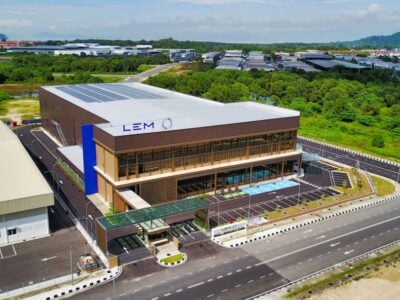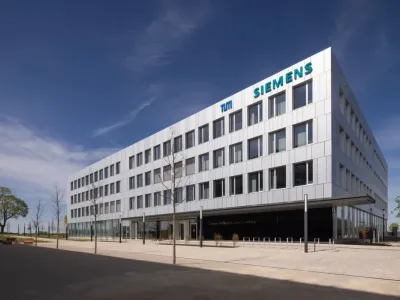
Asset tracker combines WiFi and NB-IoT cellular
A System-in-Package (SiP) with an integrated LTE-M/NB-IoT modem and GPS from Nordic Semiconductor is being used in a new asset tracker design alongside WiFi positioning.
New York-based Crosby Technologies is using Nordic’s nRF9160 SIP in its ‘ShipSafe’ asset tracker along with a 3200mAh battery for a two year battery life.
ShipSafe enables users to remotely monitor the location and condition of valuable shipments using widespread cellular infrastructure. Critical equipment being monitored during the Covid-19 pandemic include ventilators, biomedical equipment and human organs for transplant as well as high-end industrial equipment.
 ShipSafe takes advantage of the nRF9160 SiP’s support of eDRX and eDRX in NB-IoT at very low currents to extend battery life to over two years between charges with unlimited location requests. eDRX dramatically extends the time that a cellular IoT device can spend in a very low power sleep mode from just a few seconds to up to 40 minutes before waking up still synchronized with LTE-M’s “paging windows” – the period when data can be transmitted and/or received from the network. The nRF9160 SiP also supports Power Saving Mode (PSM), a second energy-saving function..
ShipSafe takes advantage of the nRF9160 SiP’s support of eDRX and eDRX in NB-IoT at very low currents to extend battery life to over two years between charges with unlimited location requests. eDRX dramatically extends the time that a cellular IoT device can spend in a very low power sleep mode from just a few seconds to up to 40 minutes before waking up still synchronized with LTE-M’s “paging windows” – the period when data can be transmitted and/or received from the network. The nRF9160 SiP also supports Power Saving Mode (PSM), a second energy-saving function..
When the device wakes up, it uses Wi-Fi tracking to determine its position within 10m and reports that location using the nRF9160 SiP’s LTE-M connectivity. This method of tracking extends the ShipSafe’s battery life to approximately two years on a single charge.
The SiP’s 64MHz Arm Cortex-M33 processor runs the LTE-M cellular connectivity and all the other product functionality in 1 MB Flash and 256 KB RAM.
ShipSafe uses Wi-Fi signal triangulation as a primary means of tracking, leveraging the location of over five billion Wi-Fi routers. If the device senses limited Wi-Fi signal strength and is unable to report a location with satisfactory accuracy, Shipsafe determines its location using traditional GPS functionality. ShipSafe’s software and platform is provided by M2MD Technologies, an Atlanta-based software firm, that develops IoT cellular systems with improved power and latency.
Next: Asset tracker system design
ShipSafe includes an accelerometer which can detect and report whether the monitored shipment has suffered a potentially damaging impact while on route to its destination, and an LED which can be remotely triggered to aid with visually locating a package. Additionally, the device has a built-in temperature and humidity sensor, which precisely relays temperatures of shipments while in transit.
Once logged into the smartphone app, the user can scan a new ShipSafe tracker ID, scan the shipping label, place the tracker in the box with the asset and ship. The shipment can be monitored in transit and, on arrival, re-scanned and recorded as delivered. ShipSafe is then sent back to the fulfillment centre for re-use. Users can also employ the app to track groups of shipments, for example, those that are due to arrive on a certain date, or those that are destined for a specific region.
“It’s the combination of features like the processor and memory, speed of operation, and low power consumption that makes the nRF9160 a winning product. It has truly been a game-changer for us,” said Jerry Pietroforte, Chairman of Crosby Technologies. “Compared with a competing cellular product we used previously in development, the nRF9160 draws less power by a significant order of magnitude because of the speed at which it performs location data transactions. The SiP is far and away the fastest solution we’ve tested.”
“The Nordic SDK is extensive and it’s easy to build on the feature set that’s included with it,” said Chuck Link, CTO and President of M2MD. “That accelerated our development program because we were able to take the SDK’s asset tracking-features and then just customize the software for our particular use case.”
“When we designed the nRF9160 SiP we knew that in addition to the cellular IoT connectivity, the product’s compact dimensions, power consumption, application processor, memory, and GPS functionality would be important to customers building applications in the logistics segment,” says Geir Langeland Nordic Semiconductor’s Director of Sales and Marketing. “What Crosby Technologies has done with ShipSafe is develop hardware, software, and a business model that makes maximum use of the capabilities of the nRF9160 to develop a compelling asset-tracking solution.”
The rechargeable 3200 mAh lithium-ion polymer (LiPo) battery is custom-manufactured for ShipSafe, which measures 120 x 75 x 16 mm and weighs 145g
The nRF9160 SiP is certified for global cellular IoT applications, comprising a dedicated application processor and memory, multimode LTE-M/NB-IoT modem with integrated RF front end (RFFE), GPS, and power management in a compact package. The processor communicates with the LTE modem through a BSD secure sockets API and supports the application layer protocol (for example CoAP, MQTT or LWM2M) and the application itself.
The modem supports both SIM and eSIM connections over the 700 to 2200 MHz LTE bands with 23 dBm output power and single pin 50 Ω antenna- and UICC-interfaces. The LTE stack layers L1-L3, IPv4/IPv6, TCP/UDP, TLS/DTLS are part of the modem firmware.
ShipSafe will be commercially available in November 2020 and will operate on AT&T’s CAT-M1 LTE-M NB-IoT network.
crosbytech.io; www.nordicsemi.com
Related NB-IoT articles
- TESTS SHOW 5G IoT LINKS OVER SATELLITE
- PARTNERSHIP TO DEPLOY FIRST 5G NARROWBAND-IoT OVER SATELLITE
- WAKE UP SIGNAL TEST FOR IMPROVED POWER EFFICIENCY
Other articles on eeNews Europe
- European chip firms concerned over US export controls
- Cyber attack hits Tower
- CMOS terahertz startup gets EC equity backing
- Electronica moves fully virtual
 If you enjoyed this article, you will like the following ones: don't miss them by subscribing to :
eeNews on Google News
If you enjoyed this article, you will like the following ones: don't miss them by subscribing to :
eeNews on Google News



